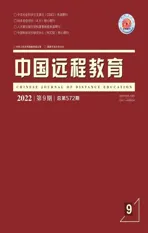Abstracts
2022-11-20
Facilitating active aging in the new era:setting standards for constructing open universities for the elderly
Shuyu Wen,Bing Li and Xingyan Mu
In order to cope with the increasingly serious situation of population aging,the value orientation of China's aging policy has gradually changed from "negative aging" to "positive aging",and the priority of development has also shifted from the physical and mental health to the human capital of the elderly.This new trend provides an opportunity for the development of education for the elderly.In recent years,education for the elderly has gradually pivoted to the blended mode.As a new model,the Open University for the Elderly set up by the Open University of China has been widely recognized by society and developed rapidly.However,this model has many problems in its educational orientation,leadership mechanism,teaching staff,teaching management,and other practical aspects,and lacks unified guidance and planning,which restricts its continuous development.In the light of this situation,it is imperative to set standards for constructing open universities for the elderly and establish an indicator system.Informed by research and practice in China and other countries,this paper explores the issues of construction standards in terms of policy,practice,and theory,putting forward a standard framework,and constructing an indicator system of this framework.It is hoped that this study carries implications for future research and practice.
Keywords:active aging;lifelong education;senior education;open university;open university for the elderly;learning society;open education;lifelong learning
Multimodal data-enhanced research in education sciences:development tra--jectory and challenges
Hongchao Peng and Yuqing Jiang
Given its affordances for comprehensive,accurate,and faithful profiling of learning,multimodal data has become an emerging trend in supporting research in education sciences.However,its development over the past 20 years has not been systematically analyzed.Using the methods of bibliometrics and content analysis,this study sets out to review 209 articles published in major Chinese and international journals.Findings show that both domestic and foreign research on education sciences supported by multimodal data has roughly gone through three stages:budding stage,expansion stage,and fission stage.It is found that in terms of content,foreign research shows two "small universe" trends:multimodal discourse and multimodal physiology,while domestic research focuses on the latter and that in terms of data analysis,multimodal discourse analytics and multimodal learning analytics are equally favored at home and abroad.Another finding is that the concept of research on education sciences supported by multimodal data has evolved in three aspects:(1)in terms of data evidence,it has extended from behavioral evidence to physiological evidence;(2)in terms of data analysis,it has transformed from statistical analytics to multimodal learning analytics;and(3)in terms of learning mechanism,it has shifted from event-centered to human-centered.However,multimodal data fusion,research paradigm shift and data privacy remain the major challenges it faces.Implications of the findings for research and practice are also discussed.
Keywords:multimodal data;learning analytics;education science;research;data fusion;research paradigm;research trends;research status;research challenges
STEM education: dilemma and reflection
Mang Li and Changqiu Yi
Nowadays,STEM education is a high-profile subject in school education.It is argued that STEM education is instrumental in cultivating students'overall qualities and improving their thinking and innovation skills.However,STEM education has problems that need to be solved urgently in teaching practice such as being formalistic,excessive use of technology and single-value orientation,hence causing its development to deviate from its original intention.This is because STEM education has a weak theoretical foundation and a tendency to over-rely on technology and ignore the important role of humanistic factors as a result of the infiltration of scientism in the process of implementation.In order to break out of this dilemma,we should pay attention to the role of philosophy in STEM education while developing the STEM literacy so that students'reflective,holistic,essential and abstract thinking and humanistic spirit can be cultivated.
Keywords:STEM education;STEAM education;philosophy;humanity;educationalattribute;formality;over-technologization;scientism
Towards constructing a social interaction network highlighting both quantity and quality:methodological innovation and verification
Xuanyu Zhou,Li Chen,Yujuan Guo,Qinhua Zheng and Xuan Li
The social network established as a result of learner interaction is an important network catalyzing connectivist learning.However,traditional social network construction only considers the quantity of interactions between learners,and does not demonstrate the quality of interaction,hence impeding adequate interpretation of connectivist learning.Innovative research methods are needed to address this limitation.To this end,this study proposes a social interaction network construction method that pays equal attention to quantity and quality.The proposed method is tested in the first cMOOC in China.Based on isometric time slices,the characteristics of social networks are mined from three levels:the overall network,the subgroup network,and individual learners.The results show that:(1)the social interaction network of learners with equal emphasis on quality and quantity is a complex network with polycentric and selforganizing characteristics,which can betterreflectthe close degree ofinteraction between learners;(2)there are multiple cohesive subgroups in the social network,and continuous interaction among learners within subgroups is conducive to the generation of deep interaction;(3)to some extent,learner status can predict the success of learners’learning,and the quality and quantity of learners’interaction promote each other.This study has implications for innovative social network analysis to better shed light on online learning.
Keywords:Connectivism;cMOOC;learner-learner interaction;social network;social interaction network;subgroup network;teaching interaction;learning pattern
